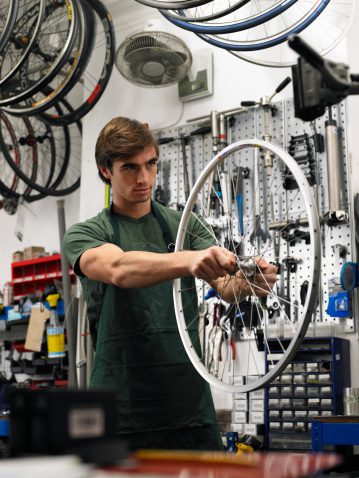Bike Maintenance 101

Having a mechanical failure at a race that you’ve prepared for weeks or months in advance is a nightmare. Sometimes unavoidable disaster can strike but often mechanical problems with your bike are caused by general wear or lack of maintenance. Regular maintenance will minimize the need for last minute bike repairs and can save money in the long run.
While you get calls every 5000 miles for car maintenance, you need to be able to judge when you should take your bike to the shop. The conditions your bike is exposed to vary so much that there’s no way to standardize when to take it in. Mountain bikes require more maintenance than road bikes given the conditions they generally endure. However, the more you ride your bike, the more it needs attention.
When you consider the time you put into training, the amount of money spent on travelling to races, entry-fees and time off from work, the price of regular tune ups is small by comparison. Be sure to schedule an appointment for your tune-up well in advance of a race. If you’re planning to ship your bike, you’ll want to do it even earlier as it’s important to get in a ride or two after the tune up to ensure everything is working well and feels right. Making an appointment also minimizes how long you’ll be without your bike leading up to the event.
Some races offer neutral support. However, neutral support is not meant to be a major overhaul of your bike. If your chain is worn when you arrive you have neglected your bike for longer than you should have. Gear adjustments and brake adjustments required after packing your bike can be fixed at neutral support, but overhauling the bearings on your bottom bracket is not what you should be attempting the day before the race.
Here is a guide to what your local bike store is going to look at when they tune your bike:
- Chain wear
Signs that your chain needs to be replaced, are trouble shifting or skipping gears, slackness in the chain or just an excess of noise. The cheapest way to extend the life of your drivetrain is to regularly replace your chain.
- Cassette wear
When your cassette is worn certain gears will constantly skip. Generally, the cogs are worn the most in your favourite gear so when you are frustrated by noise and an excess of movement in your favourite gear, you might need a new cassette. Often if you wait too long to replace your chain you’ll have to replace both the cassette and the chain at the same time.
- Brake Pads
Visual inspection will let you know if your brake pads are worn out. Don’t wait too long to replace them as the metal that holds the pad in place will ruin your carbon wheels in an instant if it rubs on your wheel.
- Tires/Tubulars
Inspect your tires for embedded debris and cuts. Sometimes those things left in your tires can work their way through and cause a flat. Tires that have been ridden for far too long will develop a flat top. This is not a fast rolling tire and is inviting a puncture because the casing is thin and compromised.
- Condition of your cables and housing
Housing and cables should be visually inspected for kinks, cracks, cable fray, and corroding or fraying metal bits. When your housing isn’t lubed and replaced regularly your shifting will be slow and imprecise.
- Parts condition
Don’t keep riding when your parts are bent or broken. It will eventually cause another problem and lead to disaster. This applies in particular to mountain bikers with bent derailleurs or derailleur hangars which can break off catastrophically when shifted under load.
The best bet for your “A” race is fresh tires, a fresh chain and a recent tune up. Not to be overlooked is a good cleaning as a clean bike is always faster than a dirty one. Other than that, pedal hard and keep it rubber side down on race day.
